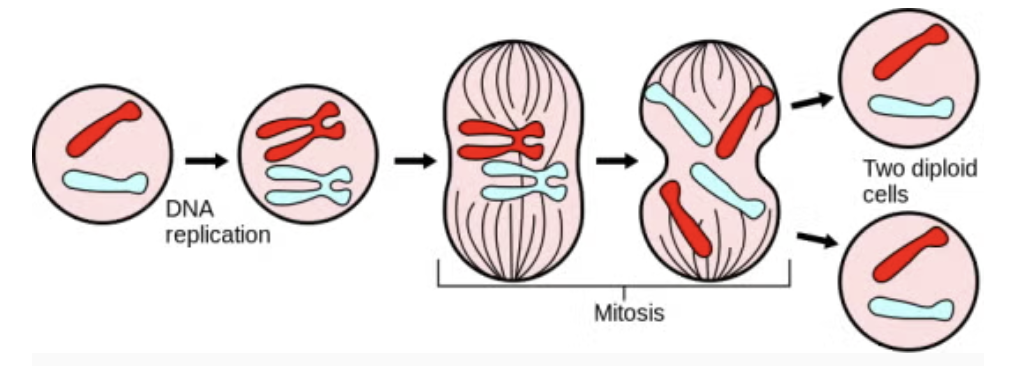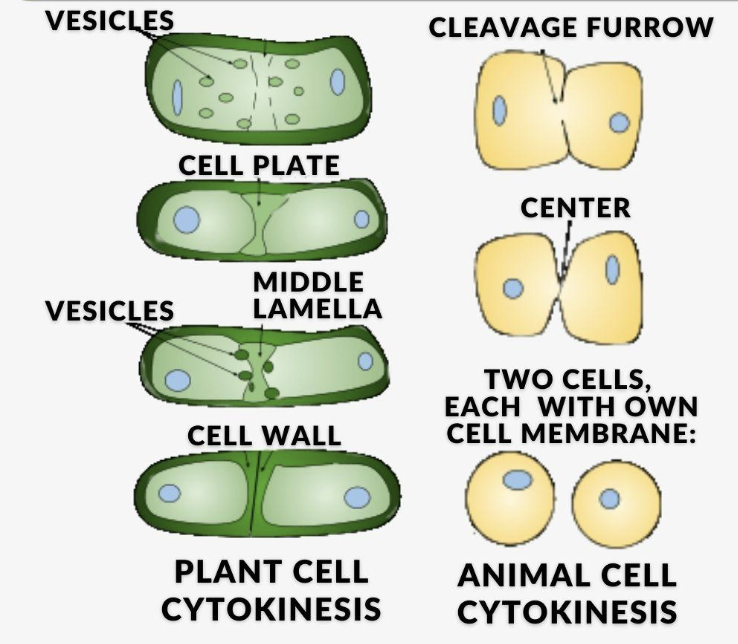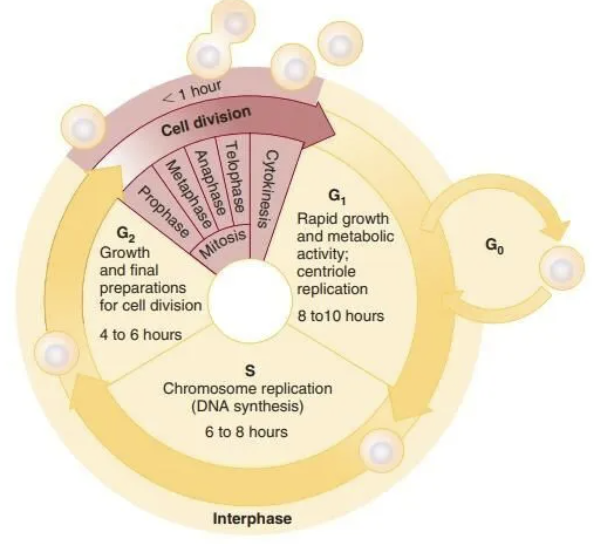cell division & cell cycle
1/32
Earn XP
Description and Tags
🍂
Name | Mastery | Learn | Test | Matching | Spaced |
|---|
No study sessions yet.
33 Terms
mitosis, 2n → 2n
2 WAYS OF CELL DIVISION:
single cell divides into 2 daughter cells that are replicas of each other and have the same number of chromosomes;
division of the cell’s nucleus
for growth & repair;
produces body cells;
diploid → diploid

meiosis, 2n → n
2 WAYS OF CELL DIVISION:
divides into 4 daughter cells that have half the number of chromosomes;
reducing # of chromosomes by half is important for sexual reproduction & provides for genetic diversity.
interphase
the stage the cell is in before it starts dividing & where it spends most of its time;
when a cell is getting ready to divide and start the cell cycle;
cells are gathering nutrients and energy;
True
TRUE OR FALSE:
The parent cell is also making a copy of its DNA to share equally between the two daughter cells.
prophase
4 PHASES OF MITOSIS: PMAT
chromosomes condense & become distinct in diploid (2n) cell;
spindle fibers emerge from centrosomes;
nuclear envelope breaks down;
metaphase
4 PHASES OF MITOSIS: PMAT
chromosomes line up (in the middle);
each sister chromatid is attached to a spindle fiber originating from opposite poles
anaphase
4 PHASES OF MITOSIS: PMAT
centromeres split in 2;
sister chromatids (now chromosomes) are pulled toward opposite poles;
certain spindle fibers begin to elongate the cell
telophase
4 PHASES OF MITOSIS: PMAT
chromosomes arrive at opposite poles & decondenses;
nuclear envelope material surrounds each set of chromo;
mitotic spindle breaks down;
2 diploid cells formed
cytokinesis
this is the process after the splitting of the nuclear chromosomes;
here, the cytoplasm & cell membrane split, resulting in 2 daughter cells

crossing over/genetic recombination
during meiosis, this process, where a small portion of each chromosome breaks off and reattaches to another chromosome, happens;
this is the reason full siblings made from egg and sperm cells from the same two parents can look very different from one another
Meiosis I
MEIOSIS:
Meiosis ___ halves the number of chromosomes and is also when crossing over happens
Meiosis II
MEIOSIS:
Meiosis ___ halves the amount of genetic information in each chromosome of each cell;
end result is 4 daughter cells (haploid, n)
haploid
this only has one set of chromosomes (half the number of chromosomes as the parent cell)
8 PHASES OF MEIOSIS:
chromosomes become distinct
8 PHASES OF MEIOSIS:
chromosome line up by pairs
8 PHASES OF MEIOSIS:
chromosome pairs move towards each pole;
sister chromatids are attached to each other.
8 PHASES OF MEIOSIS:
cell splits & 2 haploid cells form;
nuclear membrane reappears & is followed by cytokinesis
8 PHASES OF MEIOSIS:
2 haploid cells ready for division;
chromosomes begin to condense accompanied by the dissolution of the nuclear membrane and the disappearance of the Golgi apparatus and ER complex
8 PHASES OF MEIOSIS:
chromosomes line up;
hromosomes are connected to the centriole poles at the kinetochores of sister chromatids through the microtubules
8 PHASES OF MEIOSIS:
sister chromatids head towards each pole;
simultaneous splitting of the centromere of each chromosome and the sister chromatids are pulled away towards the opposite poles.
8 PHASES OF MEIOSIS:
each cell splits;
4 haploid cells formed;
because of independent assortment & crossing over, variation occurs;
chromosomes dissolve again into an undifferentiated lump and a nuclear envelope develops around it
True
TRUE OR FALSE:
Followed by cytokinesis, telophase II marks the end of meiosis. Four haploid daughter cells are formed as a result.
interphase
CELL CYCLE:
a phase in the cell cycle characterized by increased cell size & DNA replication in preparation for cell division;
nucleus is NOT DIVIDING & chromosomes are DECONDENSED
G1 - cell growth
S - DNA synthesis
G2 - more growth, prep for mitosis

interphase
CELL CYCLE:
phase is characterized by synthesis of diff. proteins & transcription of DNA to RNA;
engulfment of large amounts of extracellular material;

G1 or Gap 1
INTERPHASE SUB-PHASES:
1st stage of interphase;
no major notable microscopic change;
Activity state of the cell: Quite active at the biochemical level
Cell grows intensively
Accumulation of energy resources to ensure successful completion of DNA replication.
False, S phase should be G1
TRUE OR FALSE:
In the S phase, accumulation of the building blocks of chromosomal DNA (nucleotides, sugar, and phosphate groups) & DNA-associated proteins happens.
Synthesis or S phase
INTERPHASE SUB-PHASES:
2nd stage & is the longest phase of interphase;
marked by the complexities involved in the duplication of genetic material via the DNA replication process
semi-condensed chromatin configuration
UNDER S PHASE:
this is the state of nuclear DNA during entire interphase
synthesis
INTERPHASE SUB-PHASES:
Formation of sister chromatids ( the identical pairs of DNA);
Attachment of sister chromatids at the centromeric region;
Duplication of centrosome;
Formation of mitotic spindle apparatus from the 2 duplicated centrosomes
centrioles
these are cylindrical organelles are composed of microtubules and are involved in organizing the microtubules that form the spindle fibers during cell division;
play a critical role in the separation of chromosomes during mitosis
True
TRUE OR FALSE:
During interphase, centrioles play a crucial role in the organization of the cell’s cytoskeleton. They form the basis of the microtubule organizing structure/center (MTOC), which is responsible for arranging the microtubules that help maintain the cell’s shape and transport organelles and other molecules around the cell.
Gap 2 or G2 phase
INTERPHASE SUB-PHASES:
3rd stage;
Marked by cell’s replenishment activities;
High protein synthesis levels & number of chromosome manipulation events;
duplication of several cell organelles;
dismantling of the cytoskeleton;
some spurts of additional cell growth;
cell finally polishes and prepares for the mitotic phase
G0
CELL CYCLE:
___ is a distinct state and to answer whether it is part of the cell cycle (or part of the interphase) or not will highly depend on how these concepts are interpreted or contextually defined;
permanent state for some cells
a quiescent state in which cells can remain for an indefinite period of time, but the cell retains the ability to re-enter the cell cycle phases and undergo division.